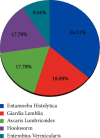Nutritional Status and Associated Factors among Primary Schoolchildren from Pastoral Communities, Mieso-Mulu District, Sitti Zone, Somali Regional State, Eastern Ethiopia: Institution-Based Cross-Sectional Study
- PMID: 34603774
- PMCID: PMC8483933
- DOI: 10.1155/2021/6630620
Nutritional Status and Associated Factors among Primary Schoolchildren from Pastoral Communities, Mieso-Mulu District, Sitti Zone, Somali Regional State, Eastern Ethiopia: Institution-Based Cross-Sectional Study
Abstract
Background: Child undernourishment is the disturbance of body function arising from a dietary imbalance between body demand and supply, which is the most serious public health problem in developing countries.
Objective: This study aimed to assess the magnitude of nutritional status and associated factors among full-cycle primary schoolchildren in pastoral communities in the Mieso-Mulu district, Sitti Zone, Somali Regional State of Ethiopia.
Methods: An institution-based cross-sectional study design was used. Study participants were selected using two-stage sampling procedures. Data were collected using structured, translated, pretested, and interviewer-administered questionnaires. The weight and height were measured using a calibrated digital scale and a Seca Rod stadiometer, respectively. Microscopic identification of intestinal parasites was done. Multicollinearity was checked for independent variables. Height for age z scores (HAZ) and body mass index for age z scores (BAZ) were used to determine the nutritional status of children. Logistic regression with both bivariate analysis and multivariate analysis was applied to identify associated factors with the nutritional status of children. Adjusted odds ratios were reported and the level of statistical significance was declared at a P value <0.05.
Results: The magnitudes of thinness and stunting were 13.1% [95% CI: 10.6%, 15.7%] and 24.6% [95% CI: 21.3%, 27.9%], respectively. Being male, not using a bed net, and the presence of intestinal parasitic infection were among the factors associated with thinness. Family size of less than five, household food insecurity, and unavailability of the latrine were among the factors associated with stunting.
Conclusion: This study revealed that stunting and thinness are major health problems among schoolchildren. Household food insecurity, intestinal parasitic infection, bed net utilization, and the availability of latrine were some of the major factors significantly associated with undernutrition. Local policymakers, health programmers, nutritionists, health practitioners, and nongovernmental organizations should enhance the nutritional status of schoolchildren by using information dissemination interventions, particularly in improving waste disposal, sanitation/hygiene, latrine facilities, and school-based deworming. Furthermore, awareness creation using nutrition promotion and encouraging communities to attempt to diversify locally available and low-cost nutritionally effective food items to improve food consumption and distribution within a household is recommended to reduce the prevalence of undernutrition among schoolchildren.
Copyright © 2021 Alayou Geletaw et al.
Conflict of interest statement
The authors declare that they have no conflicts of interest.
Figures



Similar articles
-
Assessment of nutritional status and associated factors among adolescent girls in Afar, Northeastern Ethiopia: a cross-sectional study.J Health Popul Nutr. 2021 Feb 23;40(1):2. doi: 10.1186/s41043-021-00227-0. J Health Popul Nutr. 2021. PMID: 33622414 Free PMC article.
-
Prevalence of Diarrhea, Intestinal Parasites, and Associated Factors Among Under-Five Children in Dabat District, Northwest Ethiopia: Multicenter Cross-sectional Study.Environ Health Insights. 2023 May 9;17:11786302231174744. doi: 10.1177/11786302231174744. eCollection 2023. Environ Health Insights. 2023. PMID: 37187706 Free PMC article.
-
Association between dietary diversity, nutritional status, and academic performance of school-age children in Southeast Ethiopia using structural equation modelling.J Health Popul Nutr. 2024 Nov 18;43(1):188. doi: 10.1186/s41043-024-00687-0. J Health Popul Nutr. 2024. PMID: 39558416 Free PMC article.
-
Prevalence and determinants of pre-adolescent (5-14 years) acute and chronic undernutrition in Lay Armachiho District, Ethiopia.Int J Equity Health. 2019 Sep 2;18(1):137. doi: 10.1186/s12939-019-1041-z. Int J Equity Health. 2019. PMID: 31477149 Free PMC article.
-
Prevalence and Determinants of Stunting and Thinness/Wasting Among Schoolchildren of Ethiopia: A Systematic Review and Meta-Analysis.Food Nutr Bull. 2020 Dec;41(4):474-493. doi: 10.1177/0379572120968978. Epub 2020 Nov 15. Food Nutr Bull. 2020. PMID: 33191793
Cited by
-
School Teachers' Perspectives on National Iron Plus Initiative Implementation: A Qualitative Study.Indian Pediatr. 2025 Jun;62(6):421-427. doi: 10.1007/s13312-025-00039-z. Epub 2025 Apr 2. Indian Pediatr. 2025. PMID: 40172590
-
Determinants of undernutrition among settled pastoralists' children aged 6-59 months in Kenya.Food Sci Nutr. 2024 May 19;12(8):5677-5693. doi: 10.1002/fsn3.4201. eCollection 2024 Aug. Food Sci Nutr. 2024. PMID: 39139966 Free PMC article.
-
Nutritional status and associated factors among school age children in Southeast Ethiopia using a bayesian analysis approach.Sci Rep. 2025 Jul 6;15(1):24141. doi: 10.1038/s41598-025-10743-2. Sci Rep. 2025. PMID: 40619564 Free PMC article.
-
Prevalence of Stunting and Its Associated Factors Among Children Residing in Internally Displaced Persons (IDP) Camps in Hargeisa, Somaliland: A Community-Based Cross-Sectional Study.Pediatric Health Med Ther. 2024 Jan 9;15:17-27. doi: 10.2147/PHMT.S439586. eCollection 2024. Pediatric Health Med Ther. 2024. PMID: 38226179 Free PMC article.
-
Evidence-based indications for ivermectin in parasitic diseases: An integrated approach to context and challenges in Peru.Parasite Epidemiol Control. 2023 Aug 1;23:e00320. doi: 10.1016/j.parepi.2023.e00320. eCollection 2023 Nov. Parasite Epidemiol Control. 2023. PMID: 37731824 Free PMC article. Review.
References
-
- Tebeje N., Bikes G., Abebe S., Yesuf M. Prevalence and major contributors of child malnutrition in developing countries: systematic review and meta-analysis. Journal of Childhood Obesity . 2017;16(44):1–7.
-
- The United Nations Children’s Fund. Nutrition for Every Child: UNICEF Nutrition Strategy 2020–2030 . New York, NY, USA: UNICEF; 2020.
-
- von Grebmer K., Bernstein J., Alders R., Dar O., Kock R., Rampa R. Global Hunger Index: One Decade to Zero Hunger: Linking Health and Sustainable Food Systems . Welthungerhilfe, Bonn, Germany, and Concern Worldwide, Dublin, Ireland; 2020.
-
- WHO. The United Nations Children’s Fund, The World Health Organization, and the World Bank. Levels and Trends in Child Malnutrition: Key Findings of the 2020 Edition of the Joint Child Malnutrition Estimates . Geneva, Switzerland: WHO; 2020. https://data.unicef.org/resource/jme-report .
-
- Yeasmin S., Islam K. Prevalence and determinants of undernutrition among school-aged slum children in Dhaka city. Bangladesh Journal of Nutrition and Health Science . 2016a;3(2):p. 1. doi: 10.15744/2393-9060.3.201. - DOI
LinkOut - more resources
Full Text Sources

